ECO00009I Cost Benefit Analysis 2020–21 Solution
Hello, dear friend, you can consult us at any time if you have any questions, add WeChat: daixieit
ECO00009I
BSc Degree Examinations 2020–21
Cost Benefit Analysis
Section A
1. Suppose that the price of a certain good at market equilibrium is £50 and the quantity sold is equal to 20. At this equilibrium, the price elasticity of supply is 2. Further assume that the supply curve is linear.
(a) Using price elasticity and the equilibirum market outcome, find the equation for the supply curve.
(b) At market equilibrium, what is the producer surplus?
(c) Imagine that a policy results in price falling from £50 to £40. What will be the change in producer surplus?
(d) What fraction of the lost producer surplus is due to the reduction of quantities supplied? What is the driving force behind the remaining loss in producer surplus?
Solution:
(a) The supply schedule has the following form:

Using elasticity, first find the value of 
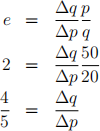
Using linearity and equilibrium outcome (20, 50)
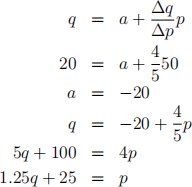
(b) The producer surplus is the area between the price line (p = 50) and the inverse supply
schedule from q = 0 to q = 20. Note that this area forms a triangle with height equal to price minus the price at q = 0 (which is 50 − 25 = 25) and base equal to the equilibrium quantity 20. Therefore, the producer surplus in this market is £0.5 ∗ 25 ∗ 20 = 250 (see Figure 1).
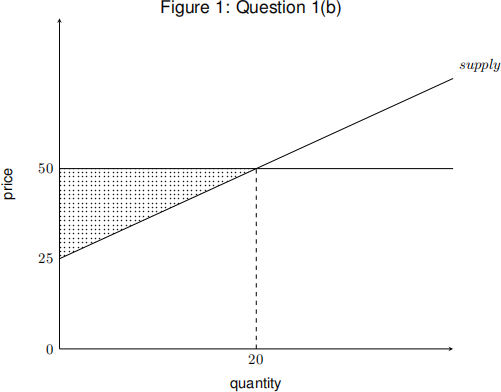
(c) Using the supply schedule, we see that at price £40, the quantity supplied falls to 12. The loss of producer surplus is equal to the area of the trapezium between the old and new price and the old and new quantities sold (see Figure 2). The loss of producer surplus is equal to 10 ∗ 12 + 0.5 ∗ 8 ∗ 10 = 160
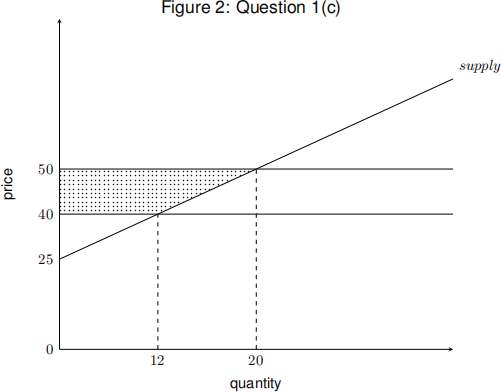
(d) The loss ofproducer surplus represented by the trapezium can be divided into a rectan- gle over the quantity still supplied and a triangle over the quantities no longer supplied. The area of this rectangle is 120 and the area of the triangle is 40. Thus, 40 is the loss in producer surplus due to the reduction in the quantity sold and the remaining 120 is due to producers receiving less for each unit that they continue to sell.
2. The initial cost of developing a vaccine for a certain disease is £80 million. The annual net benefits of having this vaccine will depend on the extent of flu infections: £3 million in a good year (with a very low infection rates), £7 million in a normal year (with a mild infection rate), and £15 million in a bad year (with a high infection rate). Data collected from the previous years indicate that over the last 100 years there have been 70 good years, 20 normal years, and 10 bad years. Assume that the annual benefits, measured in real dollars, begin to accrue at the end of the first year.
(a) Using the collected data as a basis for prediction, what are the net benefits of develop-
ing this vaccine if the real discount rate is 5 percent?
(b) What will be the break-even discount rate for this project?
Solution:
(a) The annual expected benefit of having a vaccine = 0.7 ∗ 3 + 0.2 ∗ 7 + 0.1 ∗ 15 = 5 million
PV(expected benefit of having a vaccine) = 5/0.05 = 100 million
PV(cost of developing the vaccine) = 80 million
PV(net benefits) = £20 million
(b) Breakeven discount rate: 5/80 = 6.25%
3. In order to asses some policies related to school reforms, the ministry of education wants to know the valuation that parents put on the quality of a school.
(a) How might the hedonic price technique be used to estimate the value of school quality
(b) Discuss the possible limitations of this methodology.
Solution:
(a) Basic idea: An intangible good (for which there is no explicit market price) is one of
a bundle of the characteristics of a good that is traded. For example, a house has characteristics associated with its location
Regression analysis of house prices conditioning on all other observable characteris- tics can help to isolate the implicit price of the intangible good
Differentiated products can be completely described by a vector of (observable) char- acteristics that generate utility for the consumer. e.g.: House: space, location, de´cor, warmth etc., car: comfort, speed, safety, etc.
Hedonic prices are the implicit prices of each of the individual attributes revealed through observed prices and characteristics

(b) Possible limitations
• Substantial data requirements – requires a large amount of information on product attributes
• Bundling – implicit assumption that bundles of products vary in all attributes, but this may not be the case in practice
• Multicollinearity – individual attributes may be strongly related (educated parents and high-income households), making it hard to identify the implicit price of a single attribute
• Modelling – involves making assumptions about how individual attributes affect price
• Also assuming individuals make decisions on the basis of full information (e.g. are they really fully aware of school quality?)
• Selection issues - individuals who value school quality will choose to live nearer
Section B
4. Consider a hypothetical market for cauliflower. At equilibrium, the price for each unit is £2. At this market clearing price, 1000 cauliflower units are sold. Farmers are currently not happy with the price for their agricultural produce, so the government is considering implementing a legislation that will put a minimum price cap of £3. Assume that after the price increase, farmers are willing to sell more units but the demand is only for 900 units. Further assume that the market demand and supply curves are linear and that the market reservation price (the lowest price at which any farmer is willing to sell) is £1
(a) Compute the dollar value of the impact of this policy on farmers, consumers and the society as a whole.
(b) Because of the increased price, demand in the secondary market for broccoli in-
creases. Assume that the price of broccoli is set equal to the marginal cost and that the marginal costs are constant (i.e. the supply curve is horizontal). Further, assume that there no additional externalities resulting from the reduced use of cauliflower or the increased use of broccoli. Are there any additional costs or benefits due to the increased demand for broccoli? Explain.
(a) We know two points on the supply curve (0,1) and (1000,2). Using this the equation
for supply curve will be

Further, we know two points on the demand curve (900,3) and (1000,2). Using this the equation for demand curve will be

Due to the minimum price legislation, consumers will face a reduction of their consumer
surplus equal to the area of the trapezium: £(3 − 2) ∗ 900 + 0.5 ∗ (3 − 2) ∗ 100 = 950 Farmers have dual impact. A part of producer surplus is lost due to the reduction in supply. This is equal to the area of the triangle: £0.5 ∗ 100 ∗ 0.1 = 5. For the remaining
quantities still sold in the market, producers’ gain a surplus equal to area of the triangle £1 ∗ 900 = 900. The net effect is an increase of producer surplus equal to £895.
The net effect of this policy is a loss of surplus equal to £55.
![]() No additional costs or benefits result from the outward shift in the demand curve for
No additional costs or benefits result from the outward shift in the demand curve for
broccolis. Although the shift in demand implies that broccoli is now more highly valued, the increase in cauliflower price makes neither current broccoli consumers nor new broccoli consumers better off. Any effects in the secondary market for broccoli are already fully incorporated into the primary market demand curve of cauliflowers.
5. The government of a certain country would like to preserve a piece of its land as a wilderness area. The current land owner offers to lease the land for 10 years in exchange of a lump-sum payment of £1 million to be paid at the beginning of the 10-year period. The government estimates that the land would generate a benefit of £100,000 at the end of each of the 10 years.
(a) Assuming a real discount rate of 4%, calculate the present value of the net benefit of leasing the land.
(b) Some analysts estimate that the annual real benefit will actually grow at a rate of 5%.
Recompute the present value of the net benefit assuming that these analysts are cor- rect.
(c) Imagine that the owner is willing to sell the land for £2 million. Further, suppose that the annual benefit of the land is assumed to be £100,000 (accruing at the end of each year) and the real discount rate is 4%. If the government purchases the land as a permanent wildlife area, what will be the net benefit of this purchase?
(a) Net benefits = £-188,910 (see Figure3)
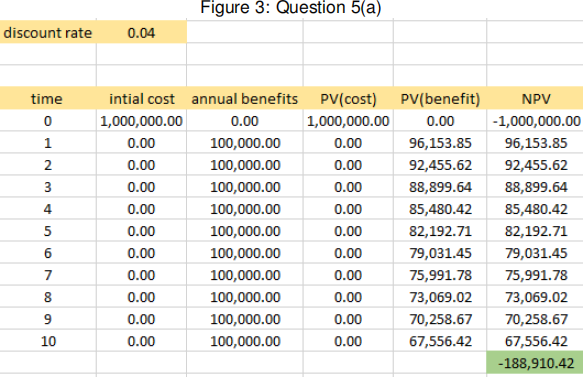
(b) Net benefits = £4,228 (see Figure4)
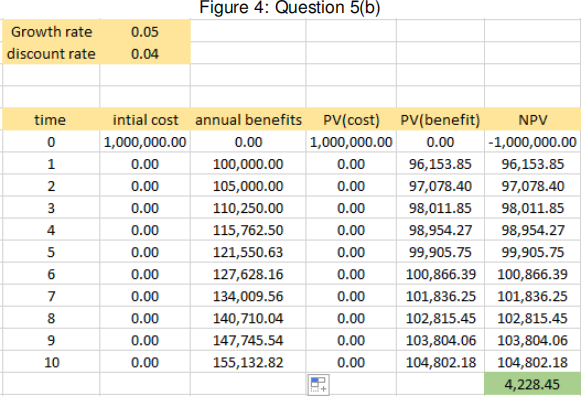
(c) PV(cost) = £2,000,000
PV(benefits) = 100,000/0.04 = £40,000,000
Net benefits = £500,000
6. A city is considering five public projects. Suppose that the city has enough budget to implement all projects that will increase the welfare of its citizens. Moreover, none of the projects are mutually exclusive. The local government hires an analyst to analyse the ef- fectiveness of each of the five proposals. The analyst finds that the projects have different benefits for the low-income households and the high-income households. The findings from the CBAs are summarized in the table below.

(a) According to the net benefit rule, which of these projects should be implemented? (b) For which of these projects might distributional considerations be an issue?
(c) Recompute the net social benefits for the five projects using a distributional weight of
3 for the low-income group and 1 for the high-income group. Under the weighted-CBA which projects should be implemented?
(d) What might be the justification(s) for using a weighted-CBA approach?
(a) According to the net benefit rule, all the projects with positive net social benefits should
be funded. Therefore, Projects 1, 2, and, 3 should be funded; but Projects 4 and 5 should not be funded.
(b) Projects 2, 3, and 5.
Projects 2 and 3 would make the the low-income group worse off, while making the high-income group better off. Because these projects also would result in an increase in net social benefits, a trade-off exists between economic efficiency and distributional considerations. Project 5 also presents such a trade-off since it would make the low- income group better off while decreasing economic efficiency.
None of the other projects present such a trade-off. Project 4 would make both groups worst off and decrease economic efficiency, while Project 1 would increase economic efficiency, but make neither group worse off.
(c) Under these weights, projects 1, 3 and 5 should be funded (see Table1.)

(d) We discussed three justifications for a distributionally weighted CBA
• Diminishing marginal utility principle
• Inequality aversion
• “One man, one vote” principle
2022-01-10